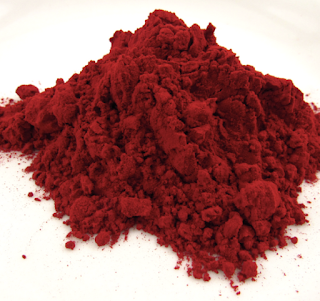An Astonishing Color
Before deciding to move here, Jim and I spent a single afternoon in Santa Fe in September 2015. I had visited years before with a group of friends spending time at Indian Market, but 2015 was the first time my spouse and I saw the city together.
We had booked a week in Taos to see the art galleries and the mountains, but we took a day to drive the 90 minutes down to Santa Fe and explore. That short September afternoon changed our lives . . . here we are.
But I don't remember seeing homes or soaking up the city vibe. What I do remember, vividly, is the color red. Scarlet, flaming, rich, deep carmine red. And tiny silvery white insects.
We spent part of our afternoon at the Museum of International Folk Art and they had a special exhibit at that time on cochineal. I will always remember that.
Cochineal is a red dye. It comes from tiny crushed up insects that live on prickly pear cactus. On a dune buggy ride on one of our trips through the west a couple years ago, our jeep guide picked a miniscule tuft of cottony fluff off a nopal (cactus) and crushed it in his fingers. Scarlet juice from a tiny bug inside flowed down his fingers. Cochineal.
Cochineal bugs have been bred and harvested for their intense colorfast dye for centuries in the southwest. In the early 1500s, the Spanish conquistadors found a thriving industry in Aztec Mexico producing and trading cochineal.
When the dried dyestuff was sent to Europe, it caused a sensation, so unlike what old world textile dyers had. It was saturated and vivid, the color of status and power, and it created a craze for red fabrics and furniture and tapestries and paints for art masterpieces that lasted centuries.
It was immensely valuable -- second only to silver imported from the new world.
And it was mysterious. Until well into the 1800s no one outside of isolated parts of Mexico was sure what it was. Did it come from a worm? A berry? A crushed flower? New Spain guarded the production of cochineal closely and the unraveling of its mystery makes for great reading in A Perfect Red: Empire and the Quest for the Color of Desire by Amy Butler Greenfield.
I just finished the book. It's great history, a good mystery, international intrigue and some science, and it brought back that seminal afternoon we spent in Santa Fe at the museum's exhibit.
But it still comes from the tiny nondescript bug in white cotton fluff that feeds on nopals and creates the most astonishing color.
Cochineal:
Coach ee Nay al






Comments
Fascinating - I'll mention it to the group.
Thank you for the pronunciation guide!
We've all ordered a copy of Dirt by Logan (I think)for our February meeting. Also reading The Forest Unseen by David Haskell a month at a time.
And we read and discussed the first chapter of Jane's book last week.
#1 granddaughter is just plain lovely, lovely, lovely.
Looking for photos from your next visit with her. And her parents. . .Peggy